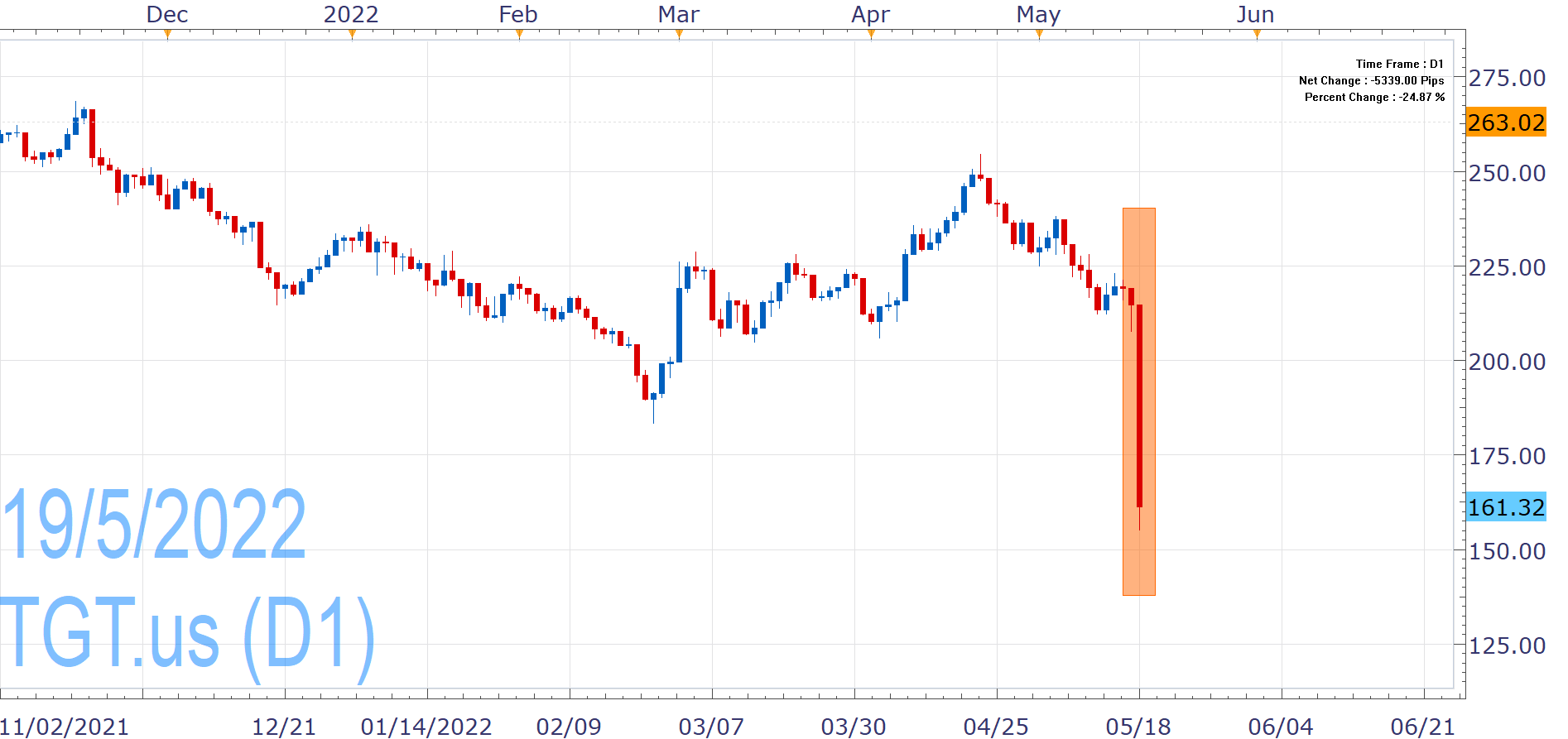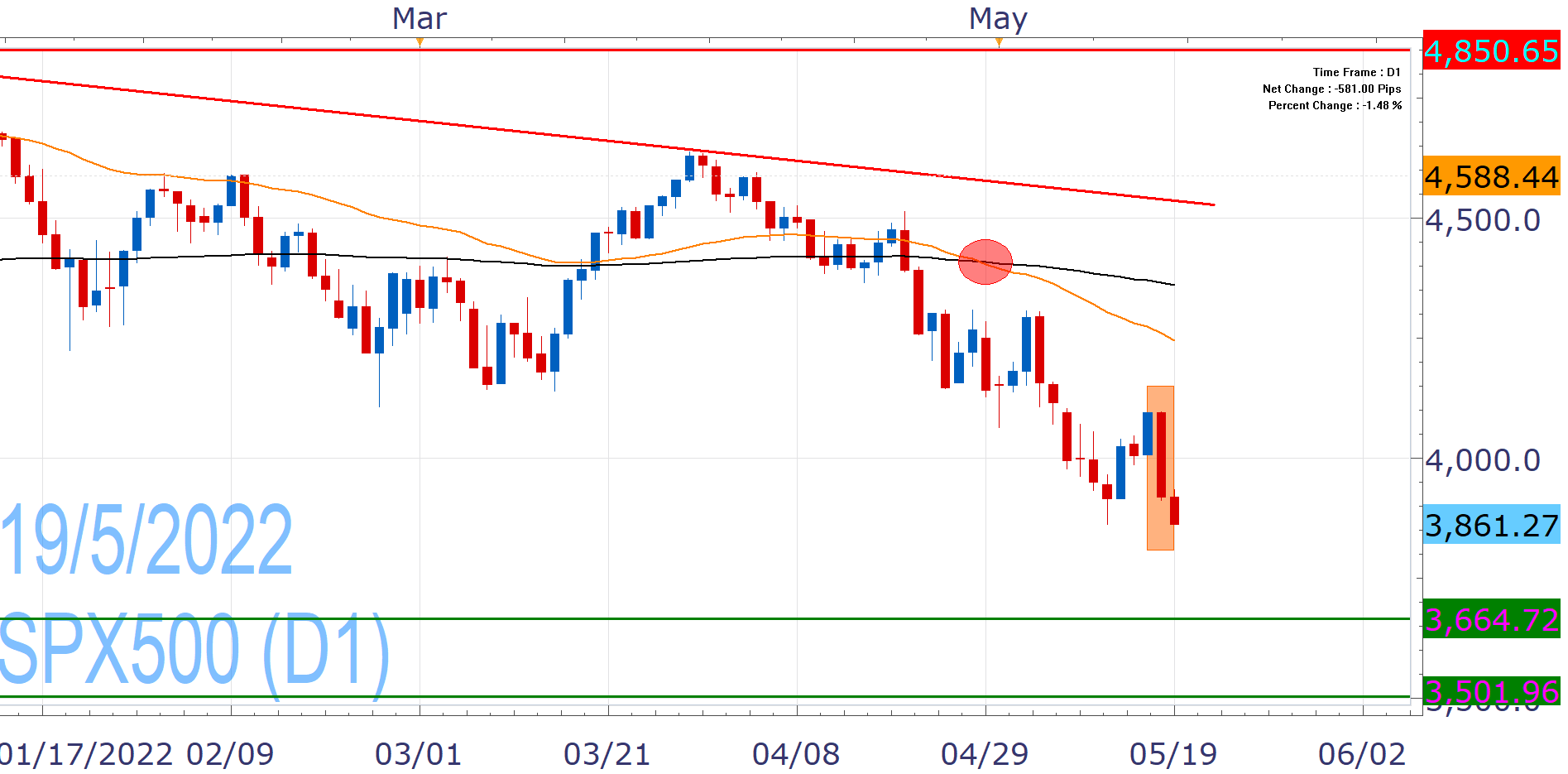SPX500 Had its Worst Day in 2+ Years on Wednesday, After Poor Earnings from Retailers & Renewed Stagflation Fears

Recent US Economic Data
This year we have seen institutions such as the IMF and the World Bank downgrading their growth forecasts, as pandemic disruptions have been exacerbated by the war in Ukraine and monetary tightening by central banks weighs.
In April, the International Monetary Fund (IMF) downgraded its 2022 global growth to 3.6% (from 4.4%) and US GDP to 3.7% from 4% in the January projections [1]. Preliminary data, showed that the annualized US GDP contracted 1.4% in the first quarter of the year.
Inflation in the US has been running rampant for quite a while now, with the Headline Consumer Price Index (CPI) having surged up to 8.5% in March year-over-year, the highest level since late 1981. The most recent data this month, showed a moderation to 8.3% year-over-year in April, but this is still exceptionally high.
On Tuesday, April Retail Sales had come in at +0.9% month-over-month, from 1.4% prior (revised), which was a solid figure and had created some optimism that consumer activity may not have been much affected by the rising prices.
The US Labor market is tight, since it has been recovering after the pandemic shock, with the Unemployment Rate having dropped to 3.6%.
Fed Monetary Tightening
The US central made a hawkish pivot late last year, switching its focus from the labor market recovery, to make fighting inflation its top priority. In pursuit of this, it embarked in an aggressive tightening path, which eventually led to the conclusion of the asset purchases program and the announcement of a balance sheet reduction plan which will begin in June.
Furthermore, it delivered its first rate increase since 2018 in March, doubling down earlier this month, with the biggest hike in more than 22 years and pointed to more tightening ahead. In the subsequent press conference, Chair Powell has stressed that inflation "is much too high", but appeared a bit conservative on future rate moves, essentially taking 75 basis points off the table. [2]
On Tuesday, Mr Powell reasserted the Fed hawkishness and its commitment to bring inflation down, speaking on Wall Street Journal's Future of Everything Festival. He said the officials will consider "moving more aggressively" if they don't see "clear and convincing evidence" that inflation is coming down, stressing that they "won't hesitate at all" to go beyond "broadly understood levels of neutral" if needed. [3]
Soft Landing?
The Fed is definitely committed to bringing inflation back to normal, but the question is whether it will be able to do so without sparking a new surge in unemployment and without plunging the economy into a recession – i.e. achieving a soft landing.
On the aforementioned speech, Mr Powell seemed tolerant to some increase in unemployment, saying that if it were to "move up a few ticks", we would still have "quite a strong labor market".
During his press conference earlier in the month, he had talked of a "soft or softish landing" [1], while last week he did not guarantee such an outcome, saying that this "may actually depend on factors that we don't control", in an interview on Marketplace. [4]
These comments definitely don't inspire much confidence in the bank's ability to avoid a hard landing, and with preliminary Q1 GDP having already contracted, the writing may already be in the wall for a stagflationary environment.
On the other hand, inflation has already shown some moderation, while economic slowdown and potential pressure on the labor market, could become a bigger headache in the future, which in turn may cause the Fed to rethink its priorities.
US Retail Giants Hit By Inflation
Major retailers where in focus this week, as they reported their quarterly results against this backdrop of tight labor market, hot inflation, higher interest rates and trade disruptions.
Target (TGT.us) saw its bottom line getting crushed, with its Net Earnings halved to $1.009 billion in Q1 (period ended in April), compared to a year ago. Its Operating Margin was crunched to 5.3% and the firm also downgraded its forward guidance for the full year, to 6% from 8% previously. [5]
Chairman and CEO of Target, Brian Cornell, attributed the low profitability "unexpectedly high costs".
Investors reacted negatively to the report on Wednesday, sending the company's stock (TGT.us) to an eye-watering fall of nearly 25% and the lowest levels since late-2020.

Rival Wal-Mart had reported its results a day earlier and things weren't much better, since Operating Income plunged to $5.3% billion in the first fiscal quarter, whereas its CEO Doug McMillon noted that "U.S. inflation levels, particularly in food and fuel, created more pressure on margin mix and operating costs than we expected". [6]
Renewed Stagflation Fears & SPX500 Plunge
These big retailers drew a clear connection between their low profitability and the high inflation and costs they faced. If these companies can't manage inflation, this does not leave much room for optimism.
Furthermore, they may try to mitigate this problem by hiking prices, which could spark an inflationary spiral, that would inflict more pain to consumers and make the Fed's job even harder.
The results created renewed fears of stagflation and market sentiment soured, as investors come to terms with the prospect of slower growth, high inflation and the end of easy money, that has fueled Wall Street's ascent.
As a result, SPX500 collapsed on Wednesday, posting its worst day since March 2020 and the height of the pandemic. At the time of writing, it is "flirting" with bear territory, losing around 20% from the January record high, which is generally considered as the threshold for such designation.
Furthermore, its erases more than 30% of the gains from its pandemic lows (2,181) to the aforementioned all-time highs (4,820). At the end of April the chart had formed a Death Cross on the daily cart, as the EMA50 moved below the EMA200, which is viewed as a strong bearish sign and could potentially lead to more weakness.
This formation had also occurred in March 2020 and the Covid-19 fueled plunge, but SPX500 was able to reverse this into a Golden Cross, after around three months and a rally with multiple record highs up to this January.

Nikos Tzabouras
Senior Financial Editorial Writer
Nikos Tzabouras is a graduate of the Department of International & European Economic Studies at the Athens University of Economics and Business. He has a long time presence at FXCM, as he joined the company in 2011. He has served from multiple positions, but specializes in financial market analysis and commentary.
With his educational background in international relations, he emphasizes not only on Technical Analysis but also in Fundamental Analysis and Geopolitics – which have been having increasing impact on financial markets. He has longtime experience in market analysis and as a host of educational trading courses via online and in-person sessions and conferences.
References
| Retrieved 19 May 2022 https://www.imf.org/en/Publications/WEO/Issues/2022/04/19/world-economic-outlook-april-2022 | |
| Retrieved 19 May 2022 https://www.federalreserve.gov/monetarypolicy/fomcpresconf20220504.htm | |
| Retrieved 19 May 2022 https://www.youtube.com/watch | |
| Retrieved 19 May 2022 https://www.marketplace.org/2022/05/12/fed-chair-jerome-powell-controlling-inflation-will-include-some-pain/ | |
| Retrieved 19 May 2022 https://corporate.target.com/investors | |
| Retrieved 27 Apr 2024 https://corporate.walmart.com/media-library/document/q1-fy23-earnings-release/_proxyDocument |


Any opinions, news, research, analyses, prices, other information, or links to third-party sites contained on this website are provided on an "as-is" basis, as general market commentary and do not constitute investment advice. The market commentary has not been prepared in accordance with legal requirements designed to promote the independence of investment research, and it is therefore not subject to any prohibition on dealing ahead of dissemination. Although this commentary is not produced by an independent source, FXCM takes all sufficient steps to eliminate or prevent any conflicts of interests arising out of the production and dissemination of this communication. The employees of FXCM commit to acting in the clients' best interests and represent their views without misleading, deceiving, or otherwise impairing the clients' ability to make informed investment decisions. For more information about the FXCM's internal organizational and administrative arrangements for the prevention of conflicts, please refer to the Firms' Managing Conflicts Policy. Please ensure that you read and understand our Full Disclaimer and Liability provision concerning the foregoing Information, which can be accessed here.